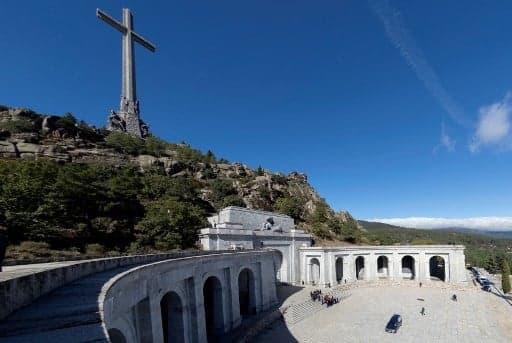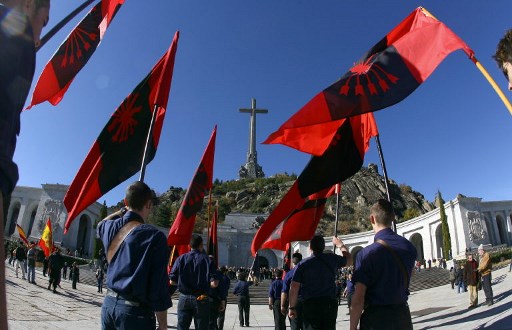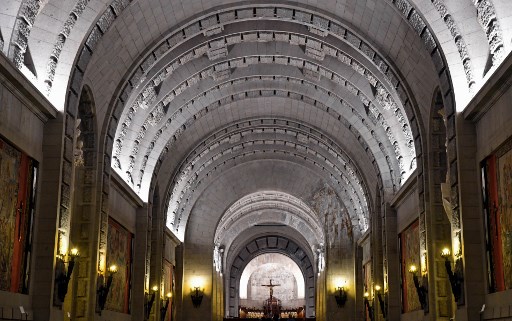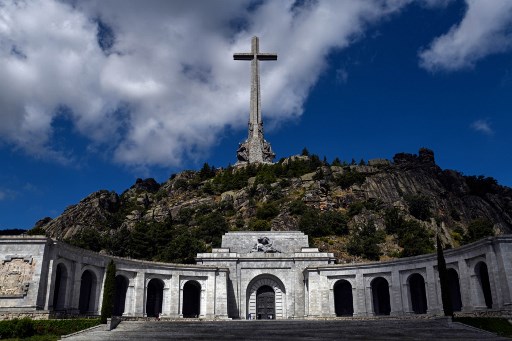What next for the Valley of the Fallen?

In what was an historic day for Spain, the remains of General Francisco Franco were removed from the tomb that lay beside the altar in the vast basilica and transferred to a more discreet grave in a municipal cemetery on the outskirts of Madrid.
But without El Caudillo, what next for the Valley of the Fallen, the controversial monument carved out of the living rock on a hillside 50 km from Madrid?
READ MORE:
-
IN PICTURES: Franco exhumed, transported by helicopter, and reburied as Spain takes 'step towards reconciliation'
-
EXPLAINED: Why Spain is rowing about digging up General Franco
Topped by a 500ft granite cross, the complex includes a Benedictine monastery with resident monks and a Prior who takes mass every Sunday.
What about the rest of the bodies?
The tomb of Jose Antonio Primo de Rivera, founder of the Falange, the Spanish fascist party, still lies in pride of place beside the altar, opposite the space now left vacant with the exhumation of Franco.
This means that the site will still be a place of pilgrimage for Spain's fascists, who used to hold rally's there every year to mark the death of Primo de Rivera on November 20th until such demonstrations were banned.

Members of the Falange party march holding the Falange flags towards the tomb of Jose Antonio Primo de Rivera, the founder of the Spanish right-wing movemen. Archive photo: AFP
tThe crypts at the Valley of the Fallen contain the remains of some 34,000 victims of the Spanish Civil War, many transferred from roadside graves where they were shot by Francoist forces, their bones jumbled together in boxes.
The Socialists won their decade long battle to finally exhume the dictator, overcoming legal hurdles placed by Franco’s descendants but what of the remains of those whose families have been fighting to have them identified and returned.
Campaigners have long called for the exhumation of graves at the site and for the remains to be returned to the descendants of those who were killed fighting for democracy.
Emilio Silva, founder of the Association for the Recuperation of Historic Memory argues that this must now be the priority.
“They should have removed the remains of Primo de Rivera and actually do something to help those people who have loved ones buried there,” he said.
Families like those of Manuel Lapeña and his brother Antonio, Republicans who were shot by Francoists in the early days of the war, dumped in a mass grave in Calatayud and then dug up years later and reburied in the Valley of the Fallen.
In 2016, a court finally approved the exhumation of the brothers and two others but the family are still waiting for access.
“We are going on for four years now while the family wait for that court order to be followed,” bemoaned Silva. “That is called prevarication.”
The process of identifying the remains of those within the crypts is a difficult one.
A team of archaeological and forensic specialists would need to access the monument’s vast ossuary and search through the bones, using DNA from surviving families members to identify them.
A time consuming and costly venture.
Turn it into a museum

The basilica is hewn out of the living rock. Photo: AFP
There is nothing at the site, which is open to the public and costs €9 for an entrance ticket, that informs the visitor about the nature of its construction or about all those buried within it.
In fact, it was built using forced labour. Republican prisoners were drafted in to dig the site out of the granite mountainside where they lived in work camp conditions on site. Many died during construction before it was finally completed in 1958. Estimates range from 15 (according to regime officials) to 27,000.
At the very least, argue campaigners, it should be turned into a centre for information about the regime which provides an accurate account of its history.
The Socialists outlined their plans in 2017: "The Valley of the Fallen will become a national centre of Memory, a place to promote the culture of reconciliation, democratic collective memory and to provide dignity and recognition to the victims.”
Prime Minister Pedro Sanchez reiterated this view on Thursday, hours after Franco was reburied in Mingorrubio cemetery when he said:
When it reopens, the Valley of the Fallen will mean something very different: it will be a memorial to a pain that must never happen again, and a tribute to all the victims of hate.”
Plans to transform the site into a place of reconciliation and healing have been put on hold until after the general election but the most likely scenario is that an international competition for ideas will be held.
Could it ever be a centre for reconciliation?
For many Spaniards, the place will never be associated with anything other than the glorification of Franco, whatever attempted transformations are made.
Some feel that not only should not a cent more of public funds be spent on maintaining the monument but that it should be left to fall into ruin.
Demolish it

Podemos have called for the site to be transformed into a memorial park, eliminating all the “fascist symbols” and desanctify it as a religious site. Most notably the leftist political party want to see the 150metre granite cross pulled down.
READ ALSO:
Comments
See Also
But without El Caudillo, what next for the Valley of the Fallen, the controversial monument carved out of the living rock on a hillside 50 km from Madrid?
READ MORE:
- IN PICTURES: Franco exhumed, transported by helicopter, and reburied as Spain takes 'step towards reconciliation'
- EXPLAINED: Why Spain is rowing about digging up General Franco
Topped by a 500ft granite cross, the complex includes a Benedictine monastery with resident monks and a Prior who takes mass every Sunday.
What about the rest of the bodies?
The tomb of Jose Antonio Primo de Rivera, founder of the Falange, the Spanish fascist party, still lies in pride of place beside the altar, opposite the space now left vacant with the exhumation of Franco.
This means that the site will still be a place of pilgrimage for Spain's fascists, who used to hold rally's there every year to mark the death of Primo de Rivera on November 20th until such demonstrations were banned.

Members of the Falange party march holding the Falange flags towards the tomb of Jose Antonio Primo de Rivera, the founder of the Spanish right-wing movemen. Archive photo: AFP
tThe crypts at the Valley of the Fallen contain the remains of some 34,000 victims of the Spanish Civil War, many transferred from roadside graves where they were shot by Francoist forces, their bones jumbled together in boxes.
The Socialists won their decade long battle to finally exhume the dictator, overcoming legal hurdles placed by Franco’s descendants but what of the remains of those whose families have been fighting to have them identified and returned.
Campaigners have long called for the exhumation of graves at the site and for the remains to be returned to the descendants of those who were killed fighting for democracy.
Emilio Silva, founder of the Association for the Recuperation of Historic Memory argues that this must now be the priority.
“They should have removed the remains of Primo de Rivera and actually do something to help those people who have loved ones buried there,” he said.
Families like those of Manuel Lapeña and his brother Antonio, Republicans who were shot by Francoists in the early days of the war, dumped in a mass grave in Calatayud and then dug up years later and reburied in the Valley of the Fallen.
In 2016, a court finally approved the exhumation of the brothers and two others but the family are still waiting for access.
“We are going on for four years now while the family wait for that court order to be followed,” bemoaned Silva. “That is called prevarication.”
The process of identifying the remains of those within the crypts is a difficult one.
A team of archaeological and forensic specialists would need to access the monument’s vast ossuary and search through the bones, using DNA from surviving families members to identify them.
A time consuming and costly venture.
Turn it into a museum

The basilica is hewn out of the living rock. Photo: AFP
There is nothing at the site, which is open to the public and costs €9 for an entrance ticket, that informs the visitor about the nature of its construction or about all those buried within it.
In fact, it was built using forced labour. Republican prisoners were drafted in to dig the site out of the granite mountainside where they lived in work camp conditions on site. Many died during construction before it was finally completed in 1958. Estimates range from 15 (according to regime officials) to 27,000.
At the very least, argue campaigners, it should be turned into a centre for information about the regime which provides an accurate account of its history.
The Socialists outlined their plans in 2017: "The Valley of the Fallen will become a national centre of Memory, a place to promote the culture of reconciliation, democratic collective memory and to provide dignity and recognition to the victims.”
Prime Minister Pedro Sanchez reiterated this view on Thursday, hours after Franco was reburied in Mingorrubio cemetery when he said:
When it reopens, the Valley of the Fallen will mean something very different: it will be a memorial to a pain that must never happen again, and a tribute to all the victims of hate.”
Plans to transform the site into a place of reconciliation and healing have been put on hold until after the general election but the most likely scenario is that an international competition for ideas will be held.
Could it ever be a centre for reconciliation?
For many Spaniards, the place will never be associated with anything other than the glorification of Franco, whatever attempted transformations are made.
Some feel that not only should not a cent more of public funds be spent on maintaining the monument but that it should be left to fall into ruin.
Demolish it

Podemos have called for the site to be transformed into a memorial park, eliminating all the “fascist symbols” and desanctify it as a religious site. Most notably the leftist political party want to see the 150metre granite cross pulled down.
READ ALSO:
Join the conversation in our comments section below. Share your own views and experience and if you have a question or suggestion for our journalists then email us at [email protected].
Please keep comments civil, constructive and on topic – and make sure to read our terms of use before getting involved.
Please log in here to leave a comment.